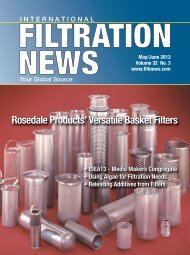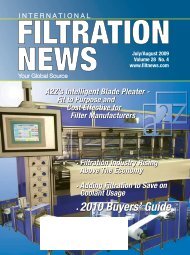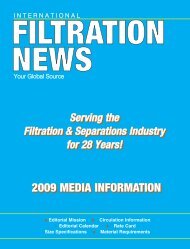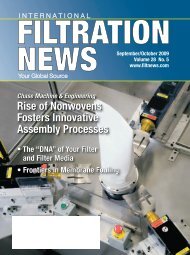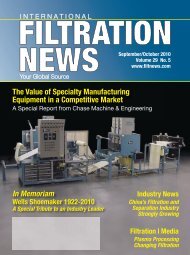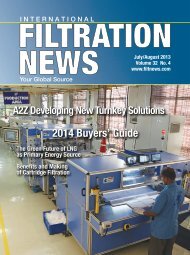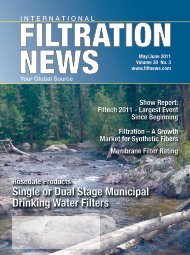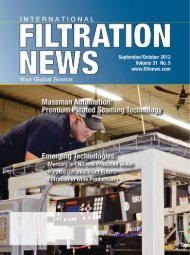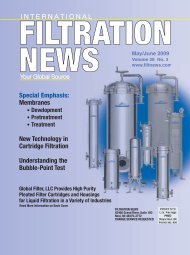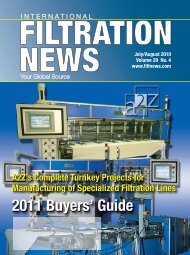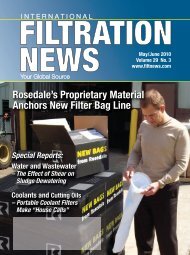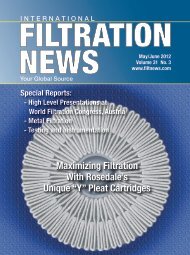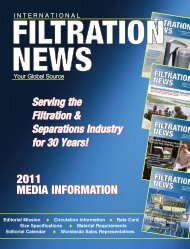Oil & Gas | Filtration - Filtration News
Oil & Gas | Filtration - Filtration News
Oil & Gas | Filtration - Filtration News
Create successful ePaper yourself
Turn your PDF publications into a flip-book with our unique Google optimized e-Paper software.
I N T E R N A T I O N A LFILTRATIONNEWSSeptember/October 2011Volume 30 No. 5www.filtnews.comYour Global Source<strong>Oil</strong> and <strong>Gas</strong> Industry <strong>Filtration</strong>• <strong>Filtration</strong> Market in <strong>Oil</strong>/<strong>Gas</strong> Sector• Filtering Heavy Feed Stock• Solutions for Hydrocarbon CondensateChase Machine & Engineering:Investing in Core Business
IN THIS ISSUESeptember/October 2011, Vol. 30, No. 5Industry | EventsWhitehouse Scientific Sponsors UK <strong>Filtration</strong> Society’s2011 Conference 4Activated Carbon Conference and Courses Comesto Pittsburgh 62012 International Activated Carbon Conference (IACC) -Call for Papers 10Testing | GAEDGAED - The Test Method “AC” Users and ManufacturersNeed to Know About 8Cover Story | Chase Machine & EngineeringManufacturer Invests in Staff, Research and Equipmentto Stay Ahead in Market 12<strong>Filtration</strong> | Minerals SlurryThe Affects of Varied Pressure on the Production ofMinerals Slurry 14Instrumentation | PorometryMeasuring Pore Size in Single Hollow Fiber Membranesby Capillary Flow Porometry 18<strong>Oil</strong> & <strong>Gas</strong> | <strong>Filtration</strong>The <strong>Filtration</strong> Market in the Unconventional Fuels Sector 24The Challenge of Filtering Heavy Feed Stocks 28Separation Solutions for Hydrocarbon CondensateDehydration Systems in the <strong>Oil</strong> and <strong>Gas</strong> Industry 34Produced Water | <strong>Filtration</strong>Improving Operational Performance and ReducingCosts With Innovative Clean Water Technology 37 $'!%'#% " & "(&'%+ '%'#", '%'#" %' " & '#%, '%" )+ '#, # ('#"& #% +%#%#" #""&'# (! # *** '"*&#!Cover courtesy ofChase Machine & EngineeringPublished byINTERNATIONALMEDIA GROUP, INC.6000 Fairview Road, Suite 1200Charlotte, NC 28210 USAPhone: +1-704-552-3708Email: info@filtnews.comInternet: www.filtnews.comCarol and Arthur Brown, FoundersKlaas DeWaal, Publisher and CEOAntoinette DeWaal, Associate Publisherand Vice PresidentEditorial DepartmentKen Norberg, Editor in Chief, Ken@filtnews.comAdrian Wilson, Intl. CorrespondentChen Nan Yang, China CorrespondentEditorial Advisory Board, See page 3Administration DepartmentBarbara Ragsdale, Barbara@filtnews.comCirculation DepartmentCherri Jonte, Subscribe@filtnews.comAdvertising Sales RepresentativesUSA:Joan Oakley, Joan@filtnews.comDebra Klupacs, Debra@filtnews.comEurope:Werner Meier, w.meier@iff-media-chJudy Holland, jholland@textilemedia.comChina:Zhang Xiaohua, ifj-china@yahoo.com.cnPublication Data<strong>Filtration</strong> <strong>News</strong> (ISSN:1078-4136) is publishedbi-monthly by International Media Group, Inc.Printed in U.S.A., Copyright 2011.This publication has a requested and controlledsubscription circulation - controlled by the staff of<strong>Filtration</strong> <strong>News</strong>; mailed bi-monthly as PeriodicalsPostage Paid (USPS 025-412) in Novi MI andadditional mailing offices.<strong>Filtration</strong> <strong>News</strong> is not responsible for statementspublished in this magazine. Advertisers, agenciesand contributing writers assume liability for allcontent of all submitted material printed andassume responsibility for any claims arisingthere-from made against publisher.Mailing Address for advertising,news releases and address changes:International <strong>Filtration</strong> <strong>News</strong>International Media Group, Inc.6000 Fairview Road, Suite 1200Charlotte, NC 28210 USAPhone: +1-704-552-3708Email: info@filtnews.comInternet: www.filtnews.com& " ""%"")&'" " #% (&"&&2 • October 2011 • www.filtnews.comPOSTMASTER:Send address changes to:International <strong>Filtration</strong> <strong>News</strong>International Media Group, Inc.6000 Fairview Road, Suite 1200Charlotte, NC 28210 USA
Editorial Advisory BoardEditorial Board ChairmanEdward C. Gregor,ChairmanE.C. Gregor & Assoc. LLCTel: 1 704 442 1940Fax: 1 704 442 1778ecg@egregor.comM&A, <strong>Filtration</strong> MediaHaluk Alper, PresidentMyCelx Technologies Corp.Tel: 770.534.3118Fax: 770.534.3117alper@mycelx.com<strong>Oil</strong> Removal – Water and AirPeter S. Cartwright, PECartwright Consulting Co.cartwrightconsul@cs.comMembranes, RO,UltrafiltrationWu ChenThe Dow Chemical CompanyTel: 1 979 238 9943Fax: 1 979 238 0651Process <strong>Filtration</strong> (liquid/gas)Equipment and MediaPeter R. Johnston, PETel/Fax: 1 919 942 9092ddandp3@aol.comTest proceduresJim JosephJoseph MarketingTel/Fax: 1 757 565 1549josephmarketing@verizon.netCoolant <strong>Filtration</strong>Dr. Ernest MayerDuPont Co.Tel: 1 302 368 0021Fax: 1 302 368 1474ernest.mayer@usa.dupont.comGeneral Solid/Liquid Separationsin All AreasRobert W. McilvaineTel: 1 847 272 0010Fax: 1 847 272 9673mcilvaine@mcilvainecompany.comwww.mcilvainecompany.comMkt. Research & Tech. AnalysisHenry Nowicki, Ph.D. MBATel: 1 724 457 6576Fax: 1 724 457 1214Henry@pacslabs.comwww.pacslabs.comAbsorbent Testingand TrainingBrandon Ost, CEO<strong>Filtration</strong> GroupHigh Purity Prod. Div.Tel: 1 630 723 2900bost@filtrationgroup.comAir Filters, Pharmaceuticaland Micro-ElectronicGregg PoppeThe Dow Chemical CompanyTel: 1 952 897 4317Fax: 1 942 835 4996poppeg@dow.comIndustrial Water, Power,and Membrane TechnologyDr. Graham RidealWhitehouse Scientific Ltd.Tel: +44 1244 33 26 26Fax: +44 1244 33 50 98rideal@whitehousescientific.comFilter and Media ValidationAndy RosolGlobal <strong>Filtration</strong> Products Mgr.FLSmidth Mineralsandy.rosol@flsmidth.comTel: 1800 826 6461/1 801 526 2005Precoat/Bodyfeed Filter AidsClint ScobleFilter Media Services, LLCOffice: 1 513 528 0172Fax: 1 513 624 6993cscoble@filtermediaservices.comFabric Filters , Filter Media,Baghouse MaintenanceTony ShucoskyPall MicroelectronicsTel: 1 410 252-0800Fax: 1 410 252-6027tony_shucosky@pall.comCartridges, Filter Media,MembranesMark VanoverBayOne UrethaneSystems LLCMarketing ManagerTel: 1- 314-591-1792Email:mark.vanover@bayone.comPolyurethane SystemsScott P. Yaeger<strong>Filtration</strong> and SeparationTechnology LLCTel/Fax: 219-324-3786Mobile: 805-377-5082spyaeger@msn.comMembranes, New Techn.Dr. Bob BaumannAdvisory BoardMember Emerituswww.filtnews.com • October 2011 • 3
Industry | EventsWhitehouse Scientific SponsorsUK <strong>Filtration</strong> Society’s 2011 ConferenceIn recent years The <strong>Filtration</strong> Society’sannual conference and exhibitionhas grown in scope andscale, and this year’s event, which takesfilter media as its focus, again looks setto attract delegates from around theworld. The Filter Media 5 Conferenceand Exhibition, with associated shortcourse and workshop covering mediain gas and liquid filtration, takes placeOctober 12-13, 2011 at the RamadaHotel, Christleton, Chester, UK. WhitehouseScientific is once again one of theprimary sponsors.Dr. Graham Rideal, CEO of WhitehouseScientific is a former chairman ofThe <strong>Filtration</strong> Society and currently itsscience correspondent. “WhitehouseScientific is again very pleased to besupporting the annual <strong>Filtration</strong> Societyconference. We appreciate the valueof networking and the exchange ofideas that comes from attending conferences,listening to and meeting otherexperts in the field,” he said. “As alwayswe are privileged to have an impressivearray of speakers and I look forward toanother enjoyable event.”During the conference there will bemany opportunities for networking anddiscussion around topical filtration issueswith leaders from both industry and academia.Confereeswill also be able tocatch up with thelatest filtration productsat the trade exhibition.The fullprogram and registrationdetails areavailable at the Society’swebsite:www.filtsoc.org.SHORT COURSEThis 2011 shortcourse on October12th will review theprocesses involvedin the manufacture,properties and applicationsof filtermedia used in liquidand air (gas) filtration.ProfessorRichard Wakemanand Dr. Steve Tarletonfrom LoughboroughUniversitywill lead the course.The presenterswill focus on the4 • October 2011 • www.filtnews.compractical aspects of choosing andusing filter media for industrial applicationsand using theoretical informationto support understandingonly where necessary. Topics coveredwill include:• The Role of Media in <strong>Filtration</strong>• Fibers and Yarns for Filter Media• Woven Media – Production,Structure and Properties• Nonwoven Media – Production,Structure and Properties• Membranes and Reactive Media• Testing Filter Media for <strong>Gas</strong>Applications• Characterizing and Testing FilterMedia for Liquid ApplicationsFUTURE MEETINGSThe 2012 program of meetings ofthe <strong>Filtration</strong> Society will follow asimilar course to previous years with a‘short course’ and ‘technical visit’ earlyin the year followed by the mainmeeting of the year in October. Thecurrent program includes: IndustrialWater Recovery and Reuse (March 13,2012), Medical <strong>Filtration</strong> (May 2012)and Filter Testing and Characterisation(October 2012).Founded in London in 1964, the<strong>Filtration</strong> Society is a charitable organizationand throughout its tenurehas forged equally strong links withindustry and academia. Its primaryobjectives are to promote research anddevelopment, transfer existing technologiesinto new applications, and toadvance the fields of filtration andseparation.FNFurther details of the October conference,short course and exhibition, together with registrationinformation, are available on the <strong>Filtration</strong>Society’s website at www.filtsoc.org
Industry | EventsActivated Carbon Conference andCourses Comes to PittsburghBy Henry NowickiThe annual International ActivatedCarbon Conference orIACC-28 will be held near thePittsburgh International Airport at theHoliday Inn, October 6-7, 2011. Thisconference and training courses are focusedon activated carbons. Carbonsare applied in an amazingly wide varietyof commercial uses. Several new activatedcarbon applications areemerging and will be discussed atIACC-28. Oral presentations are 35minutes and ample time for discussionsis provided.The conference will honor threenew members by induction into theIACC Hall of Fame. An important partof IACC is awarding this prestigiousaward to individuals who have doneoutstanding technical, business, educationor stewardship for the activatedcarbon industry.This conference attracts seasonedprofessionals to beginners. Everyoneattending has a genuine interest in ourmission, which is to increase the sizeand quality of the activated carbon industry.Innovative new activated carbonproducts and services is a part of themission.FINAL TECHNICAL PROGRAMThe International Activated CarbonConference or IACC-28 presentationsand posters are as follows:•Hugh McLaughlin - Biomass toBiochar: Renewable CarbonaceousProducts•Thomas Klasson - ActivatedBiochars made from AgriculturalResidues for Biorefinery Operations•Hari Murty - 2011 ActivatedCarbon Hall of Fame Award:Special and new Activated Carbonsfrom shell, wood and otherby-products & Agricultural Products•Evan Granite - 2011 ActivatedCarbon Hall of Fame Award:Activated Carbon for MercuryCapture from Flue <strong>Gas</strong>•Jessica Sosenko - NETL TechnologyTransfer: From Idea to Marketplace•Carl Spadaro: Regulatory Guidancefor Activation and Re-activationPlants•Bill Purves: New Media and MediaTesting•Arnie Aistars: The MostPicturesque AC Plant in the World•Gautam Khanna: New GACTechnology for Metal Sequestrationand Corrosion Inhibition•Partha Basu: Arsenic Issues: Past,Present and Future•Fred Cannon - 2011 ActivatedCarbon Hall of Fame Award:Tailoring Activated Carbons forRemoving Targeted Compoundsfrom Water•Chris Mueller - Clearing the Air:New generation of Absorbents -Advances in gas-phase air filtrationfor improved indoor air quality•James Ritter - Pressure SwingAdsorption: Past, Present and Future•David Oberdick: ABC’s ofIntellectual Property ProtectionPOSTERS AND ABSTRACTS•Influence of surface hydrophilicproperties of activated carbons onbenzene adsorption from humid air•GAED comparisons: used andunused GAC for change-out decisions•SBIR/STTP Federal governmentprogram supports high risk research•Adding anti-microbial activity toactivated carbons•GAED versus iodine number forused activated carbon change-outdecisions6 • October 2011 • www.filtnews.com•AC Fox: IP and the start of revenue•GAED solves activated carbonproblems•GAED defines markets for potentialnew physical adsorbents•Development of consulting, trainingand expert witness services•Activated carbon extends the servicelife of windmills to generate electricity•Comparison of heat of immersionwith ASTM iodine and butanenumbers•Activated carbon pulverizinginstrument for performing ASTMactivated carbon tests•Pharmaceuticals and personal carecompounds in drinking watersupplies equals activated carbons atmunicipal waste water plants•GAED solves activated carbonproblemsACTIVATED CARBON SCHOOLThe Activated Carbon School of 1- and2-day short courses will be provided beforeand after the IACC-28. Takingcourses on the same trip as attending theconference is cost effective. For a list ofshort course titles, visit www.pacslabs.comfor course descriptions.2012 AC EVENTSIACC-29 Orlando FL March 20-21IACC-30 Pittsburgh PA October 5-6,FN2012.For more informationHenry Nowicki, Ph.D., M.B.A. is theConference Chairman and can be reachedby phone at (724) 457-6576 or Email:Henry@pacslabs.com.Barbara Nowicki handles logistics,registration, VISA invitation letters.Email: Barb@pacslabs.com.Conference information is available atwww.pacslabs.com.
Testing | GAEDGAED - The Test Method “AC” Usersand Manufacturers Need to Know AboutBy Henry NowickiGAED (Gravimetric AdsorptionEnergy Distribution) fullcharacterization has solved awide variety of sorbent problems(mostly activated carbons (AC), butalso zeolites, organoclays, carbonaceousand non-carbonaceous adsorbentsand absorbents) over the lastdecade (1-3). Dr. Mick Greenbank isthe inventor and developer of this mostpowerful instrumental test method. Dr.Greenbank has presented a new modelfor AC (4) at molecular scale representedin the illustration on page 10.Manufacturers and users of AC andother sorbent materials need to beaware of this powerful test methodcoined GAED.This method enables users to selectthe best AC for specific aqueous-phaseand vapor-phase AC applications.GAED provides sorbent adsorption anddesorption characteristic curves. Thesecumulative characteristic curves providethe Polanyi adsorption potentialand pore volume function. The differentialpore volumes and adsorbatebinding energies are obtained from theraw cumulative characteristic adsorption-desorptioncurve data. This enablesfull sorbent characterizations:isotherms for a wide variety of organicswhich is the most important GAEDoutcome, pore size distributions or adsorptionspace distributions, BET surfaceareas, calculated trace capacitynumbers and other data. A typicalGAED report is 20 pages.Adsorption isotherms providepractical information to determine ifyour problem is solvable with AC.For aqueous-phase isotherms:Isotherms provide the amount adsorbedon 100 grams of sorbent sampleat equilibrium. Isotherms areexpressed in X- and Y- coordinates.The X-axis is the equilibrium concentrationin water or air and the Y-8 • October 2011 • www.filtnews.com
<strong>Filtration</strong> | Minerals SlurryThe Affects of Varied Pressure onthe Production of Minerals SlurryBy Don Kitchen, FLSmidth MineralsThere are two distinct commercialfiltration options.The first is vacuum filtrationand the second is pressure filtration.Vacuum filters apply a vacuum ornegative pressure differential to pullliquid(s) from the filtration slurry.Pressure filters applies a positivepressure differential to push liquid(s)from the filtration slurry. These differenttypes of filtration equipmentare used in a vast number of industriesthat varies from minerals processing,power generation to foodgrade products. The focus of this articlewill be on Pressure filtration andFig. 1specifically the Pneumapress filtrationtechnology.The intent of this article is to discussthe affects of varied pressures onthe filtration characteristic of mineralfeed slurry. We would like to determinehow varied pressure(s) affectscake formation rates and cake drynessusing a pressure filter (PneumapressFilter technology). Severalexamples will be discussed and wewill demonstrate that increased airblowing pressure during cake formationincreases desired draining effectsand may actually reduce the volumeof compressed air required to meetproduction rates.Fig. 214 • October 2011 • www.filtnews.comPARTICLE SIZE VS.AIR PENETRATIONAs a slurry’s overallparticle size distributionchanges so does itsfilterability. A slurrysample with course particleswill dewater easierthan a slurry with very fine particles.This is due to the internal pressure/resistanceof the slurry. If thereare large void in the slurry its internalresistance is lower and it is easierfor air to penetrate the voids.This internal pressure/resistancegives a minimum air pressure (Dpm)required for air penetration. The minimumair pressure required to achieveair penetration is equal to or greaterthan the capillary pressure in theporous bed of the slurry (see figure).Once the minimum penetration pressurehas been achieved the cake willbegin to dewater and consolidate. Asthe driving pressure is increased theair is able to penetrate deeper into thesmaller pores and further dewater theslurry. By using a larger differentialpressure the minimum air penetrationpressure is achieved quicker.This decrease in time to dewater(exceed minimum air penetration)will reduce the overall cycle time ofthe filter and therefore decrease theoverall size ofthe machinerequired tomeet the customers’needs.By using asmaller machineone isable to reducecapital costsand have apositive effecton operationcost.The moralof the story isthat if a clientwants to getliquid out of
the very fine pores createdin cakes, that are Fig. 3formed from finelyground particles, theyneed to increase thepressure (as illustratedin Fig. 1).Fig. 2 depicts thevaried Pressures=P,2P,4P required to removeliquid from eachof the varying voidsizes. The smaller thevoid the higher thepressure required toclear that void of liquid.As cake forming airpressure is increasedinside the filtrationchamber more drivingfo rce is applied to thecake consequently removing the moisturefrom the smaller voids. This removalof liquid from the cake producesa more compact (dense) filter cake. Themore compact cake takes less time todry and shortens the overall cycle time,increasing production. The compactedcake is a function of the pneumaticpressure being applied during cake formation,while the cake dryness is afunction of the amount of air passingthrough the cake.void and form a cake. The process ofevacuating the void/pores is called cakeformation. Cake formation is when thevast majority of the mother liquor hasbeen driven from the slurry and a friablecake is formed. The time requiredto form a cake is the form time.After the cake has been formed itcan then be dried. Drying is usuallydone with air. The air passes throughthe consolidated cake and picks upthe liquor and removes it from theCAKE FORMATIONHow is a cake formed in a pressurefilter?The first step in cake formation is tointroduce the slurry into the filtrationchamber. Once the slurry has enteredthe chamber there are several ways todewater the slurry and form a cake. Inthe conventional vertical pressure filter afeed pump is used to drive the filtrationand form a cake. This cake is formed ontwo opposite filter cloths and the slurryfeed pump is used to form the cake.While in a horizontal pressure filter thecake is formed by pumping the slurryinto the filtration chamber and usingblow down air pressure to form thecake. In Fig. 3 the slurry at the top of thefigure and the beginning of a cake on thefilter media can be seen.The higher the pressure (pump pressureor air pressure) the faster themother liquor/water will evacuate thewww.filtnews.com • October 2011 • 15
<strong>Filtration</strong> | Minerals SlurryFig. 4cake. This rate at which the liquor isreleased from the cake forms a dryingcurve specific to that particularslurry. The Dry curve(s) are a toolused in most filtration applications.The longer the pressurized air is appliedto the cake the drier the cakewill become (there is a point whereapplying more air to the cake producesdiminishing returns and nolonger is economically viable).16 • October 2011 • www.filtnews.com
Fig. 5AIR DRYING TIMETo better understand the effect ofpressure on filterable slurry one mustunderstand the science behind pressurevs. cake formation and drying.Let’s start by looking at the cakeformation time in Fig 4.This formula can be used for severaldifferent functions but in this articlethe focus is purely on the affectsof pressure on cake formation anddrying capability.Assumptions for this discussion:the cake thickness will be optimal,the volume of solids will be consistent,and pumping pressure will be 8bar, 10 bar and 16 bar.When the slurry is pumped intothe filtration chamber this force isused only to fill the chamber area,not to act as the driving force for filtration.There may be some minimalfiltration during filter feed but this isonly due to the effect of gravity andthe filterability of the slurry. The filtrationchamber is an open chamberand the only internal resistance isflow through the filter media.The graph above (Fig. 5) is a representationof the effects of increasedpressure on cake formation and dryingtime (blowdown Pressures of 8Bar, 10 Bar and 16 Bar). Note thecake moisture vs. Air Blow timecurves. Each of these curves has twodistinct slopes. The first slope is thecake formation curve and the secondslope is the cake-drying curve.When the slurry/fully saturatedcake is forming the increased pressureallows the air to penetrate furtherinto the slurry matrix and formand dry the cake faster.www.filtnews.com • October 2011 • 17SUMMARYThere are many factors that contributeto the efficiency and effectivenessof a pressure filter. Thesefactors range from slurry composition(particle size distribution),slurry internal pressure/resistance,cake formation times and amount ofpressure applied to consolidation anddry the cake. Each of these factorsmust be considered when a client isevaluating a pressure filter for a particularproject.This demonstrates that a filter’s abilityto operate at higher pressures positivelyaffects its ability to reduce overallcycle time by forming and drying a cakefaster. This decrease in time to dewatera slurry will reduce the overall cycletime of the filter, therefore, decrease theoverall size of the machine required tomeet the customer’s requirements. Byusing a smaller filter the customer isable to reduce capital costs and have aFNpositive effect on operation cost.For more information contact:FLSmidth Minerals7158 South FLSmidth DriveMidvale, UT 84047Tel: 1-801-871-7446
Instrumentation | PorometryMeasuring Pore Size in Single Hollow FiberMembranes by Capillary Flow PorometryBy Richard Wenman and Martin A. Thomas, Quantachrome InstrumentsHollow fiber and capillarymembranes have a numberof attractive properties suchas flexibility, high surface area per unitvolume, and unique packaging opportunities,which means they can beadapted to a variety of filtration applications.However, their physical form –small diameter flexible polymeric tubes– is a challenge for determining thesizes of the largely sub-micron porespenetrating the walls. But a simple yetreliable preparation procedure combinedwith state-of-the-art laboratoryequipment can lead to successful characterizationand differentiation of singlefibers.The excellent mass-transfer propertiesof the hollow fiber construction (arelatively large lumen surrounded by alarge area of a thin porous membranewall) has led it to being utilized in numerouscommercial applications inwidely differing fields such as medical(blood fractionation), water reclamation(purification and desalination), gasseparation, and techniques using pervaporation.Other promising applicationsof this type of membrane are inthe biochemical industry (bioseparationand bioreactors). Specifically, itsbeneficial features (compared withmore traditional filtration and separationsystems) are modest energy requirements,high volume efficiency,two modes of operation (“inside-out”and “outside-in”), and low operatingcosts. To a certain extent these benefitsare offset by more-frequent fouling andinitial capital expense. The challengefaced by those needing to determinethe pore size distribution through thewalls is to find a technique which canfunctionally transfer a fluid radially,even through a single narrow fiber;making pore size measurements acrossa flat sheet, even a bundle of fibers, issimple by comparison. The difficulty ofanalyzing hollow fibers one at a timehas been overcome by a special preparationtechnique, which involves sealingan individual fiber into a specialsample holder.EXPERIMENTALPreparing a Single Hollow FiberAcrylic tube sample holders, 8mmO.D. and 30mm long were modified bydrilling the bore to 1.5mm and countersinkingeach end. Four samples ofpolymeric hollow fiber samples identifiedas samples 1, 2, 3, and 4, each havingan outside diameter of 1 mm and awall thickness of 100 µm were preparedas follows: a length of each fiber wascut and “opened” by inserting a TFEcoated wire down the lumen (center ofthe tube). This wire remained in placeduring the following procedure tomount the hollow fiber in the holder:the sample was glued and sealed insidethe acrylic using quick-drying epoxyresin. The loose end of the fiber wasalso sealed with the glue. After the gluehad started to harden in 2 or 3 minutes,the wire was removed.ANALYSISPore size distributions were determinedusing a Porometer 3Gz (QuantachromeInstruments, Boynton Beach,FL USA). The completed sample holderswere installed in an external samplemanifold (see Figure 2) in place of theusual sample holder assembly andblock. After wetting a sample with Porofilwetting fluid (Quantachrome)Figure 1. Sample mounted and glued in acrylic sample holder. The arrow showssealed fiber end.18 • October 2011 • www.filtnews.comFigure 2: External Sample ManifoldThe red arrow indicates the attachmentpoint for the acrylic sample holder. Thecylinder is a buffer volume.
up to 256 data points weremeasured over the selectedpressure / pore size range. The3G z was equipped with both10 and 100 ml/min sensors,and both ranges were used.Figure 3: Measured “wet” and “dry” flow versus pressure. The differences between all thesamples are already evident.DISCUSSIONMeasured data of flow versuspressure for wet and dryruns for all four samples areshown in Figure 3. The meanflow pore sizes were calculatedin the usual manner, at thepressure intersection of half thedry flow data with the wet flowcurve.The pore size distributionswere calculated from the measuredpressure by the Washburnequation, assuming a zero contactangle. Three of the foursamples (1, 3, and 4) have pores predominantlysmaller than 0.5 micron diameteras immediately evidenced byliquid expulsion pressures spanningthe range from 1 to 6 bar. The pores ofthe fourth sample (2) empty completelybelow 0.7 bar. The resultingpore size distributions reveal that sample2 has a very narrow distribution ofrelatively large pores – a half width oflittle more than 10% of modal value –and showing slight skewing towardssmaller sizes on the logarithmic plot. Incontrast, the distributions of pores inthe other three samples are ratherbroad, half widths up to 50% of nominal.Sample 1 appears to be effectivelysymmetrical on the logarithmic plot,
Instrumentation | Porometrythe mode.Number distributions were calculatedbased on the internal geometricsurface of the sample fibers (from grossdimensions). Samples 3 & 4 show evengreater similarity when the pore numberdistributions are compared (Figure5) in spite of their very different flowcharacteristics and the very evident bimodalnature of sample 4. The multimodalnature of sample 1 is alsopronounced in Figure 5.Figure 4: Differential percent flow versus pore size. Differences between sub-micronpores are highly resolved.whereas samples 3 and 4 show significantskewing towards larger sizes thanCONCLUSIONSA new sample preparation techniquehas been successfully employedto demonstrate thesub-micron resolution of capillaryflow porometry on what are usuallyconsidered to be “difficult” samples.This ability to measure pore size distributionsin the (membrane) wall ofa short sample of a single hollowfiber is of significant value to manufacturersand users of these materials,as it allows them to study in20 • October 2011 • www.filtnews.com
Instrumentation | Porometrymany years developing their first andsecond generation porometers. Hesubsequently formed the Xonicscompany to develop the third generationof porometers, which he continuedat WSI before joiningQuantachrome in 2010.Martin A. Thomas has more than28 years experience in the characterizationof porous materials, the last20 of those have been with Quantachrome.He is also a technical specialistbut shares much of his time inmarket development especially fornew products and applications. FNFigure 5: Differential pore number percent area versus pore size. Some significantsimilarities between samples 3 and 4 can now be seen.detail the consistency of membranespores discretely along the length of afiber.Richard Wenman is Quantachrome’sporometer specialist. Heworked for Coulter Corporation forFor more information contact:Quantachrome Instruments1900 Corporate Drive, Boynton BeachFL 33426 USATel: 1-561-731-4999Email: qc.support@quantachrome.comWebsite: www.quantachrome.com22 • October 2011 • www.filtnews.com
<strong>Oil</strong> & <strong>Gas</strong> | <strong>Filtration</strong>The <strong>Filtration</strong> Market in theUnconventional Fuels SectorBy Robert McIlvaineThe world is rapidly depleting theeasy to reach fossil fuel sources.New discoveries are smaller andmore expensive to extract. In additionthere is turmoil putting into question thereliability of these sources. The problemis exacerbated by the rapidly increasingneeds in Asia and other developing regions.As a result, much of the current investmentis being directed towardunconventional fuel sources. There arelarge short term and long term filtrationand separation opportunities in the followingcategories:GAS SHALEThe U.S. is leading the way with hydrofracturingto extract very large quantitiesof gas. However, the fluidtreatment and control costs for injectionas well as flow back are substantial.COAL-BED METHANEThe U.S. is third and Canada is fifthin terms of recoverable reserves. Chinais the leader with plans to increase productionto 40 billion m3 in 2020.HEAVY OILCanada is the world leader with anumber of new projects in oil sands.Steam assisted gravity drainage technologyrequires fluid treatment andcontrol of injection and producedwater. Environmental compliance atexisting plants is also a driving force.GAS-TO-LIQUIDSPlentiful shale gas will lead to an $8billion investment in gas-to-liquid facilitiesin the U.S. over the decade.However, the big market will be in theMiddle East.COAL-TO-LIQUIDSThe U.S. is vying with China to leadin this market. A technology advanceto use direct liquefaction could acceleratethe market.BIOFUELSThe U.S. is already the world leaderahead of Brazil. Some recent technicaldevelopments make cellulosic ethanola potential option. In 2010, U.S.ethanol production set a new record of13.23 billion gallons produced from204 plants. Global production ofethanol grew nearly 15 percent in 2010to 22.9 billion gallons.The total market for filtration andseparation equipment will rise worldwidefrom just under $1 billion thisyear to $1.3 billion in 2015.<strong>Gas</strong> shale opportunities in the nearterm present the biggest growth opportunity.Most opportunities will be in theU.S. Details on the developments of theMarcellus region of Pennsylvania andother regions are found in the freeGlobal Knowledge Orchard 1 .Coal bed methane opportunities aregeographically more diverse. The heavyoil opportunities are primarily in24 • October 2011 • www.filtnews.comCanada for the present. Coal-to-liquidopportunities are in China and the U.S.Biofuels opportunities are greatest inthe U.S. and Brazil. Despite the dominanceof the Middle East in conventionalfuels, the unconventional fuelopportunity over the next five years ismore evenly divided.SEDIMENTATION, CENTRIFUGATIONThe biggest single equipment categoryis sedimentation and centrifugation.This includes fuel waterseparators centrifuges to dewater biofuelwastes, and various settling devicesfor water and wastewater treatment associatedwith the processes.The stillage in the ethanol process issent through a centrifuge that separatesthe coarse grain from the soluble. Thesoluble are then concentrated to about30 percent solids by evaporation, resultingin Condensed Distillers Solubles(CDS) or “syrup.” The coarse grain andthe syrup are than dried together to producedried distillers grains with soluble(DDGS), a high quality nutritious livestockfeed. The CO2 released duringfermentation is captured and sold foruse in carbonating soft drinks and bev-
erages and the manufacture of dry Ice.The U.S. ethanol industry is suppliedby three centrifuge manufacturers:Westfalia Separator, Alfa Laval, andFlottweg Separation Technology Centrifugesplay a big role in heavy oil processing.AIR AND DUST FILTERSAir filters are used in compressor intakesand to protect control rooms inwhat may be corrosive atmospheres.Fabric filters are used where biomassis combusted, for transfer pointsin coal-to-liquids and for various oilsands mining applications.Scrubbers and adsorbers are used forcleanup of various exhaust gases aswell as purification of CO2 for resale inthe corn-based ethanol process.Coalescers are used to remove impuritiesfrom the fuel gas stream.MEMBRANESCross flow membranes (RO/UF/MF)are used for boiler feed water and forprocess filtration. In some cases (e.g.,Middle East)seawater is utilizedand mustbe desalinated.On-site treatmentof producedwater hasbeen successfullyaccomplishedusingReverse Osmosis(RO as theprimary treatmenttechnology).However,extension of theRO technology to the treatment offlowback water from hydraulic fractureoperations has required pretreatmenttechnologies designed to protect, andthereby extend, the life of the RO unit.A consortium of oil producers andservice companies, led by Texas A&MUniversity, has developed an RO processthat is specifically adapted to oilfieldwastewater purification, which was licensedto GeoPure Water Technologies.The RO pilot system was extensivelytested in the laboratory and field, and resultsshow that dissolved solid levels upto 50,000 mg/L can be reduced to thelevel of fresh water. Extension of thistechnology to treating frac water returnsrequired the RO unit to be protected toprevent early plugging of the membranes.Under a DOE contract, TexasA&M is evaluating pretreatment optionsthat include combination of liquid-liquidwww.filtnews.com • October 2011 • 25
<strong>Oil</strong> & <strong>Gas</strong> | <strong>Filtration</strong>centrifuges, organoclay absorbents, microfiltration,and different oil resistantmembrane materials and membranetypes. GeoPure produced a 200-gpmunit incorporating some of the pretreatmentoptions and, used it successfullyfor about nine months to treat BarnettShale frac water of at least 13,400mg/liter total dissolved solids.ProChemTech invented a sequentialprecipitation process for treatment offlowback water. The first precipitation removessuspended solids, iron, and bariumfrom the flowback water as solid,typically non-hazardous, sludge cake.The remaining scale formers (calcium,iron, magnesium, manganese, and strontium)are precipitated to make one solidsludge cake, which could be used as analkaline soil amendment or for abandonedmine spoil reclamation.The process does not materiallychange the concentration of dissolvedsolids in the FRW. ProChem concludesthat the only known alternative to theirprocess is the GE Thermal Evaporationprocess, which uses a vertical-tubeevaporator to convert industrial wastewatersinto distilled water for reuse.OTHER MEMBRANE TECHNOLOGIESMTR’s FuelSep systems purify rawgas sidestreams to premium quality fuelgas. MTR membranes easily removeH2S, C3+, CO2, N2 and water fromfuel gas at moderate pressure. Becausethese impurities are taken out of thefuel gas and returned to the compressorsuction, there are no effluentstreams to be disposed of. Any C3 + removedfrom the fuel gas goes back intothe main gas stream, so all NGL in theraw gas stream is available for downstreamrecovery, if desired.These units have no moving parts, aresimple to install and operate unattended.Many units are operating worldwide.H2S is found in natural gas in manylocations, and this high H2S gas cannotbe transported from the wellhead topipelines without treatment. MTR’smembranes can provide a simple, lowcost,compact solution for reducing H2Sin natural gas.Argonne National Laboratory andNalco Company have reached an agreementfor an electrodeionization technologyto reduce the cost of technology thatcan process biomass-based feedstocksinto biofuels and chemicals. Specifically,Argonne’s patented technology allows forthe deionizing or the continuous removalof charged products like organic acidsfrom aqueous streams and eliminates therequirement to continuously add neutralizingagents. Conventional bioprocessingtechnologies require significantcapital expenditures on energy-intensivesteps to recover these products and generatelarge waste streams.Snowpure also has experience withelectrodeionization for bioprocessing.This technology is primarily used in ultrapurewater. However, biofuels and seawaterdesalination promise to open evenbigger markets. These technologies andapplications are covered extensively inthe Free Global Knowledge Orchard 2 .26 • October 2011 • www.filtnews.com
CARTRIDGESCartridges are used in water treatmentbut also product purification. They arealso used in conjunction with the lubricationfor fans, turbines, compressors andother rotating equipment.A big application for cartridges is filtrationof the biofuel product. ParkerHannifin supplies the Turbine Series filterassemblies, which are installed on the vacuumside of the fuel transfer pump forbest efficiency and to protect precision enginecomponents from dirt, rust, algae, asphaltines,varnishes, and especially water,which is prevalent in engine fuels.SCRUBBERS AND ABSORBERSScrubbers and adsorbers are used forcleanup of various exhaust gases as wellas purification of CO2 for resale in thecorn-based ethanol process.Coalescers are used to remove impuritiesfrom the fuel gas stream.The multi-step Claus process recoverssulfur from the gaseous hydrogen sulfidefound in raw natural gas and from the byproductgases containing hydrogen sulfidederived from refining crude oil andother industrial processes. The byproductgases mainly originate from physical andchemical gas treatment units (Selexol,Rectisol, Purisol and amine scrubbers) inrefineries, natural gas processing plantsand gasification or synthesis gas plants.These by-product gases may also containhydrogen cyanide, hydrocarbons, sulfurdioxide or ammonia.MACROFILTRATIONThese are two main routes for liquefyingcoal: indirect and direct. The indirectprocess requires both particulate and acidgas removal from the flue gas stream. Ceramicfilters or venturi scrubbers are usedfor particulate removal. Acid gases are removedin processes similar to those describedabove for natural gas purification.Absorbers and coalescers have a place.The second liquefaction approachsuch as used by headwaters is direct liquefaction.With the commercial success ofa direct liquefaction system in China, thisalternative may become the preferredroute. It has lower capital costs and less ofa carbon footprint than indirect liquefaction.There is also more reliance on filtrationof liquid.The solid/liquid separation is one ofthe most important unit processes in thedirect approach. One device for primaryseparation is a pre-coat pressurized rotarydrum filter.There are a few uses of filters in othersparts of the process. One example is a filterto stabilize caustic use in tank cleanings.Ethanol plants typically have manyfermentation tanks. The system is optimizedso that one tank is offline for cleaning.This clean up is important and mustbe done in a short period of time. Causticis added through a caustic control valveto maintain peak cleaning efficiency. Inone location, an Eaton (Ronningen-Petter)filter was installed on a recirculationloop off of the caustic make-down tank.Cost savings were realized with the use ofthis filter.FNFor more information contact:Bob McIlvaineTel: 1-847-784-0012 Ext. 112Email: rmcilvaine@mcilvainecompany.comWebsite: www.mcilvainecompany.com1http://www.mcilvainecompany.com/Decision_Tree/subscriber/Tree/UnivDB/appl2.asp?ref1=4802http://www.mcilvainecompany.com/Decision_Tree/subscriber/Tree/UnivDB/prod2.asp?prodname=Electrodeionizationwww.filtnews.com • October 2011 • 27
<strong>Oil</strong> & <strong>Gas</strong> | <strong>Filtration</strong>The Challenge of Filtering Heavy Feed StocksBy Rick Jacobs, Eaton CorporationThe drive to increase profits atpetroleum refineries requiresoperators to focus on operatingefficiencies including a constant searchfor lower cost feed stocks. This searchhas led to the processing of heavier,more sour feed stocks. The most recentpush is to process more of the CanadianTar Sands. The challenge in processingthese feeds is twofold. First is simplycracking the heavy feed to make morelight ends and second is to remove thesulfur to meet regulatory limits whenproducing fuels and other products.Choosing and maintaining the rightequipment and systems to meet thesedemands is crucial. Eaton’s filtrationequipment is well-suited to help refineriesprocess these difficult feeds aswell as make their hydraulic systemswork reliably, effectively, and operate attheir maximum capacity.PROCESS FILTRATIONFeed stock filtration systems protectfixed bed catalyst units from pluggingbecause of contaminate in thecrude. The effect of plugging is highdifferential pressures that cause thebed to be shut down prior to the catalyst’sfull utilization. The heavier thefeed, the more contaminants are generallypresent and the higher the riskfor plugging. The heavier feed stocksalso are more difficult to filter becauseof higher viscosity and the presence ofasphaltenes.Eaton has more than 500 ReactoGard® systems globally installed and operating.The systems are protectingHydro-treaters, Hydro-crackers andHydro-desulfurization units. ReactoGardsystems are clean-in-place units utilizingautomatic backwashingtechnology for regeneration. This cleanin-placetechnology is an environmentallyfriendly solution compared todisposable media options that requiredisposal through incineration or othermethods. The automatic operation iscontrolled with PLC or DCS controlsproviding minimal operator intervention.Eaton’s ReactoGard V is the fifthgeneration of this technology and has:• A 50% reduction in footprint• Up to a 70% reduction in valves28 • October 2011 • www.filtnews.com
ReactoGuard system• Improved backwash efficiencyover other designs• Highly efficient media to ensurecatalyst bed operation willutilize its full reactivity potentialAmine filter unitAMINE FILTRATIONDesigned to operate in the amineloop, Eaton’s ClearAmine unit isknown for its efficiency. Higher sulfurfeeds push the amine loop harder totreat the increased volumes of sour gas.The primary issue with this is as theamine loop processes the higher levelsof sour gas it produces more corrosionin the loop. These corrosive particleswww.filtnews.com • October 2011 • 29
<strong>Oil</strong> & <strong>Gas</strong> | <strong>Filtration</strong>increase the solids load in the streamwhen using traditional slip stream disposablemedia systems. The increasedsolids load results in issues in theamine loops processing equipment.Off-line filtersHeat exchangers are particularly susceptibleto solids as they are an area ofdecreased velocity where solids falloutand foul the heat exchanger. Thiscauses increased maintenance and unplannedshutdownson theamine loop.The free solidsin the stream alsocan becomecoated with hydrocarbonsincreasingthehydrocarbon content.The incr e a s e dh y d r o c a r b o n scause foaming inthe contactor thatdecreases the efficiencyof theamine loop.Specifically designedfor this application,theC l e a r A m i n e ’sc l e a n - i n - p l a c eunit uses backwashingtechnologyto regeneratethe filter.The cleaningsequence can alsouse a purging30 • October 2011 • www.filtnews.comprocess. This allows the system to bebackwashed with water without dilutionof the amine stream or aminecontamination in the backwash water.The unit also can be set up on thelean side with an adjustable slipstream system allowing more of thestream to be filtered removing moreof the solids. The automatic procedurepermits cleaning to occur withoutoperator intervention, this meansplacing the filter on the rich side is anoption. This permits the stream to befiltered full flow, protecting downstreamequipment like the heat exchangerand minimizing the need forreplacement of disposable media onthe slip stream sentry filters.Traditional disposable media onthe rich side is not recommended becauseit increases operators’ possibleexposure to H2S lethal gas during filterchanges. These capabilities providean EHS advantage overtraditional disposable media solutionsthat risk operator exposure andrequire disposal of the used media.HYDRAULIC COMPONENT FILTRATIONOff-line Filter UnitsEffective oil service for hydraulicand lubrication systems in petroleumrefineries requires using an operatingfilter, the application of a filter unitfor off-line filtration, oil change, andfilling. To prevent contamination, thefluid should be filled through a finefilter of an off-line filtration unit.Mobile (UM) and stationary (US) offlinefiltration units with electric motorsimprove the cleanness andquality of the operating fluid andprolong its durability, thereby preventingearly failure of system components.Eaton’s expertise has led to the developmentof explosion-proof mobileoff-line filter units (UMP) in two differentsizes and performance possibilitieswith a pneumatic doublediaphragm pump. A chemically resistantmembrane, which can easilybe changed, ensures a prolonged life
cycle. Changing the filter elementwithout any tools eliminates the needfor system downtime. Due to its compactdesign and a transporting trolleymoving the unit close to locationsthat are difficult to access is easy.Stainless Steel FiltersIn the oil and gas industry, stainlesssteel filters protect compressors,pumps, and turbines. They aremounted in suction, pressure, or returnlines and are available in singleor duplex as well as filter modulesfor high filtration efficiency at highvolume flows. The goal is to preventcontaminants from entering the hydraulicand lubrication oil systemsand avoid early failure of systemcomponents, thereby significantlyimproving the system reliability.This high performance filter seriesis suitable for pressure ranges from16 bar up to 420 bar, and is easy tooperate and service. High-quality filterelements with high dirt holdingcapacities are available in differentContamination and Condition Monitoring Systemswww.filtnews.com • October 2011 • 31
<strong>Oil</strong> & <strong>Gas</strong> | <strong>Filtration</strong>filter materials. The change-overstainless steel pressure filters (EDA,EDU, EHD, EDSF series) have an additionaluser benefit, a change-overball valve that makes it possible toswitch from the dirty to the clean filterside without interrupting the operation.This makes it possible tochange or service the contaminatedfilter element while in the “off” position.Keeping Hydraulic Components andSystems Running Efficiently ThroughMonitoringMany factors can reduce the servicelife of hydraulic components and systemsin petroleum refineries. It is criticalto define and maintain a fluidcleanliness level on a continuous basisto prevent particle, water, or gas contamination.Knowing these levels is themost valuable information an operatorcan have. It permits further analysisconcerning:• Filter configuration efficiency• Changes of the wear situationin systems• Secondary contaminationAccurate, on-time information enablesthe operator to respond quicklyto adverse system changes with adequatecounteractive measures.While monitoring fluid cleanlinessmay not be new, the innovationsfrom off-line measurement to on-linemeasurement in contamination monitoringis. At the present time manufacturershave their focus ondeveloping devices for in-line measurements.Eaton is a pioneer in thisfield, developing a whole in-linemonitoring system of sensors and indicators– particle counters, watercontamination monitoring systems,and oil condition monitoring systems.Applying those measuringtechniques in different configurationsensures a continuous monitoringand state conditioning diagnosisof hydraulic systems, and even more– wear surveillance and early recognitionof damage, which is essentialfor hydraulic and lubrication systems.CONTAMINATION MONITORINGContamination has many effectson hydraulic systems in petroleumrefineries such as:• Accelerated oil aging• Shortened fluid lifetime• Failure of additives• Corrosion• Cavitation• Abrasion• Erosion• Increased wearTherefore, defining the preciselevel of contamination at any time is32 • October 2011 • www.filtnews.com
crucial for the functionality and efficiencyof a system. This involves twomethods of taking fluid samples fromthe system at regular intervals andtesting them. The first would besending such a fluid sample to a laboratoryfor analysis. The second is touse a mobile electronic instrumentdesigned for this purpose.Eaton’s condition monitoring systemsprovide accurate, immediate,mobile and stationary fluid monitoringand particle counting in accordancewith ISO, NAS, and SAEstandards. Eaton’s wide range ofproducts for particulate contaminationmeasurements are an essentialpart of any broad maintenance concept.Eaton systems are intended forin-line, off-line and many on-line applicationsas well.Eaton’s mobile ContaminationControl System CCS 4 determinesthe exact particle size distribution ofthe contamination, water saturation,and fluid temperature. Measurementresults are meant to be a base forevaluating the wear condition of hydrauliccomponents, adherence tonorms, and early detection of damages.The CCS 4 can be handled inon-line pressurized operating modesas well as for depressurized samplings(e.g. tank sampling). Measurementsare displayed as particlenumbers according to contaminationclasses:fabricated strainers, process and utilitywater filtration with automaticbackwash units, gas liquid separators,and a full line of disposablemedia solutions.FNFor more information contact:Eaton Corporation - Hydraulics Group<strong>Filtration</strong> DivisionTel: 1-732-767-4203 - Fax: 1-732-494-0793Email: MargaretDeAngelis@eaton.comWebsite: www.eaton.comRead our magazine online: www.filtnews.com• ISO 4406:99• ISO: 4406:87• NAS 1638• SAE AS 4059• Water saturation and temperature• Theoretical water content in ppmInternally stored measured valueseasily transfer using an USB-interfaceor a RS232-interface. By monitoringand controlling the oil cleanlinesslevel, early detection of solid particlesand other contaminants helpavoid unplanned maintenance; significantlydecrease operating costs aswell as unforeseen shutdowns.Eaton also offers many other filtrationand separation solutions includinga full line of cast andwww.filtnews.com • October 2011 • 33
<strong>Oil</strong> & <strong>Gas</strong> | <strong>Filtration</strong>Separation Solutions for HydrocarbonCondensate Dehydration Systems inthe <strong>Oil</strong> and <strong>Gas</strong> IndustryBy Thomas H. Wines, Ph.D., Olivier Trifilieff and Fabrice Daire, Ph.D., Pall CorporationHydrocarbon condensate producedwith natural gas increasesthe profitability of gasdevelopment projects. The condensatewill be used or marketed under variousforms depending on the productionrate, composition, and available downstreammarkets and transportation network.At onshore production facilitiescondensate is usually treated by a stabilizationprocess prior to export. Thedehydration operation reduces thevapor pressure of the condensate (naturalgasoline) by eliminating the lightor lower boiling fractions to make itsafe for storage at atmospheric conditionsand for transportation.Figure 1: Salt deposits in de-ethanizer reboiler top tubesheet before and aftercleaning. (Photos courtesy of Crew Energy Inc.)IMPACT OF INEFFECTIVEThe presence of salty, acidic water andsolid particulate in the unstabilized condensateis known to cause various problemsin the stabilization plant or in theexport pipeline. Impurities including glycoland methanol used for hydrate inhibition,along with corrosion inhibitors, tendto create stable condensate/water emulsionsthat are difficult to separate efficiently.Condensate dehydration plant operatorshave reported that several of thefollowing consequences may arise dueto water carry over that contains dissolvedsalts and/or solids:• Reduced stability of plant operations• Quality issues with the final products,such as gasoline and LPG, and thepossible need to reprocess• Excessive corrosion and salt depositsinside the stabilizer and reboiler (seeFigure 1)• Increased power consumption due tothe ingression of excessive levels ofwater and loss of heat transfer causedby contaminant deposits• Frequent shutdown of the stabilizationtrain for cleaning purposes, causing adrop in production and hence a loss ofrevenue if the flow rate cannot becompensated by the other stabilizationtrains.S EPARATION OPTIONSVarious separation technologies areavailable in the oil and gas industry toeliminate salty water from unstabilized34 • October 2011 • www.filtnews.com
condensate. These include gravity settlers,knock-out vessels with meshpads, electrostatic desalters and cartridgecoalescers. All technologies havespecific features which make themsuitable for a given set of operatingconditions. For instance, not all technologiesare capable of separating stableemulsions with low interfacialtensions (IFTs). To improve the condensatedehydration process, the selectionof the appropriate technologyor combination of technologies requiresa thorough understanding oftheir advantages and limitations.FIELD TEST RESULTSWater carryover from condensateseparators was evaluated in the field.The results from four different condensatedehydration plants in the MiddleEast and North Africa region are providedbelow. All four plants faced variousproduction issues in theirstabilizers. The plant operators implementedtroubleshooting programs, includingthe evaluation of condensatecontamination. Condensate was testeddownstream of the existing separators,which consisted of two gravity separators,a knock-out drum with a meshpad, and a glass fiber cartridge coalescer.See Table A for a summary ofcondensate contamination levels.In addition, the condensate wastested downstream of a pilot-scale highefficiency PhaseSep® polymeric cartridgecoalescer. The performance datais reported in Table B. Typical visual resultsare shown in Figure 2.Figure 2: Condensate samples collectedfrom a polymeric cartridge coalescerduring a typical field survey.These field surveys illustrate thatwater carry over downstream of separatorsis an ongoing challenge in theoil and gas industry, and that performancewill vary among different types ofseparators in the presence of stableemulsions.CARTRIDGE COALESCERSCartridge coalescers use a fibrousmedium to coalesce finely disperseddroplets. To achieve the separation,they do not require the use of chemicalsor electricity. Instead, separationwww.filtnews.com • October 2011 • 35occurs when the medium capturesdroplets on the fibers through adsorption.Next, the droplets coalesce toform larger ones and then release due
<strong>Oil</strong> & <strong>Gas</strong> | <strong>Filtration</strong>Figure 2: Condensate samples collected from a polymeric cartridgecoalescer during a typical field survey.Figure 3: Overview of typical cartridge coalescer layoutin a horizontal configuration.to increased drag caused by the bulkflow. A horizontal cartridge coalescersystem is depicted in Figure 3.The system consists of a horizontalcoalescer cartridge stage followed by asettling zone that relies on the densitydifference between the water and thecondensate to separate the coalesceddroplets. The coalesced droplets arecollected in a sump located at the bottomof the housing at the end of the settlingzone. The condensate/waterinterface is moni tored in the sump by alevel control system.The performanceofcartridge coalescersvariesaccording tothe type ofcartridge thatis used. Dueto disarming(coating offibers) in thepresence ofsurfactants,conventionalglass fiber coalescersareusually restrictedtoe m u l s i o n swith IFTsgreater than20 dyne/cm.Given theattributes ofthe condensa t e / w a t e remulsion inthe condensatedehydrati o n36 • October 2011 • www.filtnews.comapplication, high efficiency polymericcartridge coalescers are more appropriate.High efficiency coalescers areparticularly suited to handling emulsionswith low to very low IFTs rangingfrom
Produced Water | <strong>Filtration</strong>Improving Operational Performance andReducing Costs With Innovative CleanWater TechnologyBy Hari Parthasarathy, MyCelx Technologies CorporationIn the age of heightened environmentalconcern and regulation, the oil andgas industry is charged with meetingnew, stringent operational challenges.Meanwhile, industrial operations are alsosteadily increasing, thus adding to the risingdemand for sustainable water treatmenttechnology, especially in growingwater scarce regions. These operationalchallenges will only increase over time,and in order to achieve cost-effective andsustainable operations engineers neednew innovative technologies for watertreatment that is economical and robust.MyCelx Technologies has an awardwinning clean water technology for oiland gas applications that is gaining recognitionworldwide for its ability to removeoils and hydrocarbons to critically lowlevels. The technology operates on thenovel principal of chemical cohesion,which is a clean break from other existingtechnologies, and this enables MyCelx toremove free, emulsified and dissolved oilsand hydrocarbons in water.With installations worldwide withflow capacities up to 1,300 m3/h,MyCelx specializes in the recycle andreuse of industrial wastewater and producedwater, and is deployed in variousprocess water and wastewater treatmentapplications such as:• Produced water treatment foroverboard discharge and reinjection• Side stream process cooling watertreatment• Process wastewater recycle and reuse• Desalination RO membrane foulingprotection• Sour water stripper and re-boilerfouling protectionwww.filtnews.com • October 2011 • 37
Produced Water | <strong>Filtration</strong>MyCelx Clean Water system installed at a petrochemical facility in JubailIndustrial City, Saudi Arabia.38 • October 2011 • www.filtnews.comMyCelx Clean Water Technologyand Equipment replaces existing methodsof oily wastewater treatment with arobust, fail-safe, simple and cost effectiveprocess.The MyCelx system can remove oilsand hydrocarbons from the water toless than 1 ppm, and produce recyclablewaste that can be reused as complimentaryfuel. The hydrocarbon-freewater is either discharged in accordancewith regulations or processedthrough desalination equipment suchas ion exchange, RO or evaporators forwater reuse or safe re-injection.Since efficient water treatment is imperativefor successful operations,MyCelx Clean Water Technologies arerapidly being considered and implementedby major oil and gas companiesworldwide. The ability of MyCelxClean Water Technology to remove oilsand hydrocarbons to such critically lowlevels has caught the attention of companiessuch as Chevron, SABIC, andQatargas where the solutions are beingconsidered for applications such aswastewater recycle and reuse and producedwater treatment.PETROCHEMICAL WASTEWATERIn an industrial complex in the MiddleEast with up to 20 petrochemicalplants, it is estimated that if 50-60% ofindustrial wastewater is recycled andreused within the facilities, it wouldsave $40-50 million per year. This doesnot include savings in energy and reducedenvironmental footprint of operations.Currently, the processedwastewater is traditionally treated inCWWTPs and portable water processreuse is purchased at high costs.MyCelx designed a breakthroughpoint source wastewater treatment solutionthat has been implemented toachieve less than 1 ppm oil content inprocess wastewater and in some casesas low as 0.06 ppm. The benefits to theend user are to either discharge thewastewater into central wastewaterplants with reduced hydrocarbon load,or to recycle and reuse the wastewater,which reduces the overall water load to
Produced Water | <strong>Filtration</strong>the CWWTPs.MyCelx systems operate at a capacityof 1-1000 m3/h and benefit the enduser by:• Reducing hydrocarboncontaminations and pollution atthe source.• Reducing exposure of the operatorsto the oils and hazardoushydrocarbons during process,creating a higher safety health andoperational standard.• Increasing water conservation andfacilitates recycle and reuse.• Reducing hydrocarbon load to aCWWTP by more than 50-90%.• Reducing wastewater haul-off andhazardous waste disposal.At a large, new petrochemical facilityin Saudi Arabia, MyCelx was contractedto quickly deliver a state of theart process wastewater treatment systemwith capacity to process 50-75 m3/h,and yield results of >0.06ppm levels ofhydrocarbons from the original 200-500ppm makeup consisting of oils, phenolsand benzene. Due to the immediateclient need, MyCelx was the only technologyprovider able to fabricate, deliverand implement the system withina record period of 8 weeks. Additionally,the compact size and lower weight ofthe MyCelx solution and equipment enabledthe shipment to be airlifted to thefacility while other technologies hadless-efficient methods of delivery.40 • October 2011 • www.filtnews.comRO FOULING PROTECTIONMyCelx Clean Water Technologycan also effectively protect during theRO desalination process 100-1,000m3/h, removing oils and hydrocarbonsto lower than even 0.1 ppm levels andsubstantially reducing bio-fouling.RO Membrane Desalination Processis a critical component for the recyclingand reuse of industrial process wastewater.However the tight RO membranesare verysensitive to fouling,limiting their feasibilityfor use inmajor segments ofindustrial processwastewater generatingsources likeO&G production,refineries and petrochemicalplants.One of the criticalfouling componentsof the RO membranesis organics.Organic foulingof RO membranescan be caused by biologicalcontaminationand trace oilsand hydrocarbons,which are commoncontaminants inwastewater andwater intake channels.Further, ROmembranes are susceptibleto irreversiblefouling in a short period oftime. These contaminants can causebuild-up in the generators and result inhigh opportunity costs, water productionlosses, high-energy consumptiondue to build-up and high overall operatingcosts.MyCelx RO Pretreatmentprocesses implemented in O&G refining,petrochemical and manufacturingfacilities are able to guaranteeconsistent removal of all oil andsolids to below 0.3 ppm. In previouscases, MyCelx solutions have yieldedhighly efficient results:• RO membrane life doubled• Water production increasedby >50%• Energy consumption decreasedby 10-20%PRODUCED WATER TREATMENTSeveral global O&G companies arecurrently using or evaluating MyCelxClean Water Systems for ProducedWater Treatment for onshore and offshoreapplications because of MyCelx’sability to remove all free and emulsifiedoils to breakthrough low levels. Asengineers move towards offshore dischargeof produced water rather thandischarging into underground wells,they need a fail-safe produced watertreatment solution that can reliablymeet the stringent 15 ppm requirementsfor overboard discharge, andMyCelx is the only technology that canconsistently meet these discharge requirements.The key benefits of MyCelx ProducedWater Treatment system are:• Fail-safe solution for removing all freeand emulsified to reliably meet andexceed the 15 ppm overboarddischarge requirements.• Small footprint and low operatingcosts. A MyCelx system is 40-50%less weight and less than a quarter ofthe size of other technology systems.• Treatment flexibility. Depending onwhat the water treatment needs are,
MyCelx Produced Water System replaces larger footprint equipment that resided on red footings.the MyCelx system can beimplemented as a stand-alonetreatment solution or retrofitted toboost performance of an existingwater treatment train.MyCelx Produced Water Treatmentsystem was first implemented in theU.S. for Anadarko Salt Water Managementfacilities. Various technologieslike CPI Separators, float cells, nutshell filters, organo clay, carbon andMyCelx Clean Water Technology wererigorously evaluated by at the productionsites. After undergoingmonths of intense field evaluation, anoptimum produced water treatmentsystem was designed for full-scale implementationto consistently meet the10 ppm surface discharge requirement.To date, the MyCelx systemshave treated more than 15 millionbarrels of water with an average qualityof less than 0-5ppm oil in water.Based on its successful performanceonshore, the MyCelx systemwas designed for several offshoreplatforms in deepwater Gulf of Mexico.The MyCelx Clean Water systemwas also selected as a 2011 Spotlighton New Technology Award recipientat the Offshore Technology Conferencein Houston, Texas. Recent evaluationsshowed the MyCelx systemproducing a sustainable dischargeunder 10 ppm including emulsifiedoils and dissolved hydrocarbons,even when tested under upset operatingconditions.As can beseen in the pictureabove,MyCelx ProducedWaterSystem replaceslarger footprintequipment thatresided on redfootings.With environmentalregulationsexpectedto become morestringent in thefuture, innovativewater technologywith thislevel of performanceanddemonstratedsuccess is industrychanging.MyCelx offersclean watertechnology systemsthat arerobust, fail-safeand smart withwww.filtnews.com • October 2011 • 41a lower cost, smaller footprint andlower weight compared to conventionaltechnologies.FNFor more information visit: www.mycelx.com
Mini Mart Ads42 • October 2011 • www.filtnews.com
www.filtnews.com • October 2011 • 43Mini Mart Ads
Advertiser IndexPage WebsiteA2Z <strong>Filtration</strong> Specialities 28 www.a2zfiltration.comAFS Conference Inside Back Cover www.afssociety.orgAhlstrom 5 www.ahlstrom.comAir Filter, Inc. 7 www.airfilterusa.comAshby Cross Co. 38 www.ashbycross.comChase Machine and Engineering, Inc. Back Cover www.chasemachine.comContract Pleating Services 26 www.solentech.comDexmet Corporation 37 www.dexmetfilter.comEd Gregor 10 ecg@edgregor.comEnpress LLC 25 www.enpress.comFerguson Perforating 30 www.fergusonperf.com<strong>Filtration</strong> Society UK 39 www.filtsoc.orgFranklin Adhesives & Polymers 23 www.franklinadhesiveandpolymers.comFTG 37 www.ftginc.comHollingsworth & Vose 21 www.hollingsworth-vose.comINDA Inside Front Cover www.inda.orgIndustrial Netting 4 www.industrialnetting.comJCEM-USA 31 www.jcem.chKeystone Filter Division 20 www.keystonefilter.comLawrence Industries, Inc. 40 lawrenceindustries@juno.comMagnetool Inc. 41 www.magnetoolinc.comMetalex 36 www.metlx.comMetcom Inc. 32 www.metcomusa.comMyron L Company 16 www.myronl.comOrange Research, Inc. 15 www.orangeresearch.comOrival Inc. 17 www.orival.comPerCor Mfg. 32 www.percormfg.comPerforated Tubes 19 www.perftubes.comQuantachrome Instruments 29 www.quantachrome.com/3gRosedale Products 11 www.rosedaleproducts.comSealant Equipment 33 www.sealantequipment.comSolent Technology Inc. 8 www.solentech.comSonobond Ultrasonic 35 www.sonobondultrasonics.comSpati Industries, Inc. 27 www.spatiindustries.comSpin Tek <strong>Filtration</strong> 1 www.spintek.comXinxiang Tiancheng Aviation 9 www.tchkjh.comAd Representatives:AUSTRIA, GERMANY,SWITZERLANDBruno FischWerner MeierIFF Media AGEmmersbergstrasse 1CH-8200 Schaffhausen,SwitzerlandTel: 41 52 633 08 88Fax: 41 52 633 08 99Email: b.fisch@iff-media.chEmail: w.meier@iff-media.chBENELUX, FRANCESabine DusseyINTERNATIONAL JOURNALSDuppelstr. 7D-42781 Haan, GermanyTel: 49 2129 348390Fax: 49 2129 3483910Email: Sabine.Dussey@dussey.deCHINAMr. Zhang XiaohuaMobile: 0086 13522898423Mr. Han JiweiMobil: 0086 13810778772Email: ifj_china@yahoo.com.cnBeijing, ChinaINDIAYogesh JogBRIDGE MEDIAD-302, Shiromani ComplexNr Nehrunagar – Satellite RoadOpp Ocean Park, Satellite,Ahmedabad – 380015.Tel: 91 79 26752628Telefax: 91 79 26762628Mobile: 98242 31895Email: media.bridge@gmail.comITALYFerruccio SilveraSilvera PubblicitáViale Monza 24, I-20127 Milano, ItalyTel: 39 02 284 6716Fax: 39 02 289 3849Email: ferruccio@silvera.itJAPANKenji Kanai3-9-25, Wakamatsudai, SakaiOsaka 590-0116, JapanTel: 81 6 6343 4513Fax: 81 722 93 5361Email: fwpb9629@mb.infoweb.ne.jpKOREAYoung-Seoh ChinnJES MEDIA Inc.2nd Fl.,ANA Building257-1, Myungil-DongKangdong-Gu,Seoul 134-070, KoreaTel: 82 2 481 3411/3Fax: 82 2 481 3414Email: Jesmedia@unitel.co.kr44 • October 2011 • www.filtnews.comTAIWANBuildwell Intl. Enterprise Co. Ltd.No. 120, Huludun 2nd St., Fongyuan CityTaichung County 42086, TaiwanTel: 886 4 2512 3015Fax: 886 4 2512 2372Email: buildwel@ms23.hinet.netUNITED KINGDOMJudy HollandTextile Media Services Ltd.2A Bridge Street, SilsdenKeighley, BD20 9NB, UKTel: 44 1535 656489Fax: 44 8700 940868Email: jholland@textilemedia.comUSA, CANADABob MooreRAMCOP.O. Box 4032Cave Creek, AZ 85327Tel: 1 480 595 0494Fax: 1 480 595 1749Email: ramco@qwest.netALL OTHER COUNTRIESKen NorbergEditor, International Fiber JournalPO Box 265Winchester, TN 37398 USATel: 1 202 681 2022Email: ken@filtnews.com
The World’s Largest Manufacturerof Custom Web Handling EquipmentMADE IN THE USAHollow Fiber LineFor more than 25 years, systems as small as a single fiber lab scalepilot line, to large-scale systems that produce membrane fibers forthe filtration of blood, water, and even gases.• Spinnerets and rinse baths• Godets• Dryers and texturizers• Winders• Lab lines• Production lines• Potting centrifuges• Blending kettlesLiquid <strong>Filtration</strong>Bag MachineProduce a wide range of productsfor varying filtration needs.• Ultrasonically seal and cut to lengthneedle punch or spunbound/meltblownfilter media• Hot air tube-forming technology• Welding bag bottoms eliminatesneedles and thread, and providesconsistent bond strengthCHASE MACHINE & ENGINEERING, INC.324 Washington St., West Warwick, RI 02893P: 401.821.8879 F: 401.823.5543www.chase machine.comIf you produce hollow fibers or various liquid/air filter manufactured outof nonwoven materials, Chase Machine has the material handling, customdesign, and manufacturing expertise required to offer a more efficientand cost-effective assembly solution. Tap our vast knowledge andexperience in web handling applications to find the perfect solution toyour filtration production needs. Test materials and assembly methods,and ensure final product quality at our Materials Application Lab.For more information contact Guy Gil (guygil@chasemachine.com).



